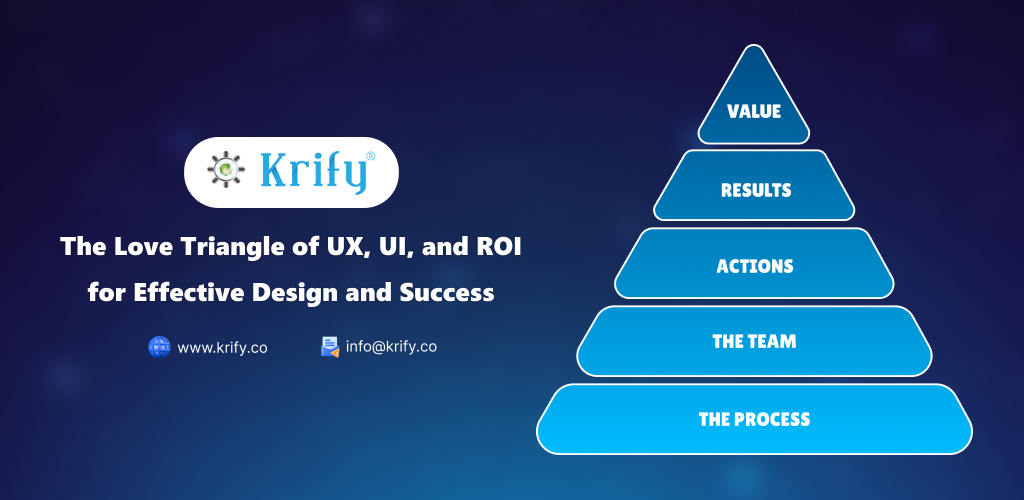In the world of digital products, three critical components determine their success: User Experience (UX), User Interface (UI), and Return on Investment (ROI). While each plays a unique role, together, they create a powerful love triangle that can either make or break a design’s effectiveness. In this blog, we’ll explore the intricate relationship between UX, UI, and ROI, and how balancing them is key to achieving business success.
Defining UX, UI, and ROI
1. User Experience (UX)
UX refers to the overall experience a user has when interacting with a product. It encompasses everything from ease of use, functionality, and how well the product meets user needs to how enjoyable the experience is. A well-designed UX leads to higher user satisfaction and engagement.
2. User Interface (UI)
UI refers to the visual design and interactive elements of a product. It focuses on aesthetics, layout, buttons, icons, typography, and color schemes that users interact with. Good UI makes a product visually appealing and easy to navigate, creating an intuitive flow for users.
3. Return on Investment (ROI)
ROI measures the financial performance of a product by comparing the benefits or profits generated to the cost of investment. In the context of design, ROI is about how well a product’s UX/UI can attract and retain users, ultimately leading to higher revenue or conversions.
The Interplay Between UX, UI, and ROI
The relationship between UX, UI, and ROI is inseparable. When designed thoughtfully, UX and UI can significantly enhance ROI by improving customer satisfaction, increasing engagement, and reducing churn.
1. UX Impacts ROI
- Higher Retention: A positive user experience keeps customers coming back. Intuitive navigation, seamless functionality, and meeting users’ needs lead to higher satisfaction and loyalty.
- Lower Bounce Rates: A well-thought-out UX reduces frustration. When users find what they need quickly and easily, they are more likely to stay, engage, and convert.
- Word of Mouth & Referrals: Satisfied users are more likely to recommend the product to others, which can lower customer acquisition costs and organically boost revenue.
2. UI Influences Perception and Interaction
- First Impressions Matter: UI is the first point of contact. A well-designed interface instantly communicates trust, professionalism, and value. A poor UI, on the other hand, can deter users before they even explore the product.
- Visual Consistency: Consistent design elements like colors, typography, and layout contribute to a cohesive brand experience, increasing the likelihood of users feeling comfortable and confident using the product.
- Aesthetic-Usability Effect: Studies show that users often perceive aesthetically pleasing products as more usable, even if they have slight usability issues.
3. The ROI of Good Design
- Faster Conversions: When UX and UI align, they create a smooth path to conversion—whether it’s signing up for a newsletter, purchasing a product, or engaging with content.
- Reduced Development Costs: Investing in strong UX/UI design upfront can save costs later. Clear design reduces the number of revisions, reworks, and future updates, ensuring a more efficient development process.
- Increased Customer Lifetime Value (CLTV): Happy users who experience a great UX and UI are more likely to stay longer, interact more frequently, and spend more money over time.
The Balancing Act: Achieving Harmony Between UX, UI, and ROI
1. User-Centric Approach
Always start with the user in mind. Thorough user research helps understand pain points, behaviors, and needs. A design that puts users first—through seamless UX and an attractive UI—naturally leads to higher satisfaction and better ROI.
2. Iterative Design Process
A successful design isn’t static. Continuously testing and gathering feedback from real users ensures that UX and UI evolve with user expectations, resulting in sustained and increased ROI over time.
3. Measuring ROI Beyond Revenue
ROI isn’t just about money. Consider metrics such as:
- Customer satisfaction: Are users happy with the product?
- Engagement rates: How often do users interact with the product?
- Retention rates: Are users returning? These non-financial metrics ultimately contribute to long-term financial success.
Case Studies
- Airbnb: By revamping their UX to simplify the booking process, they reduced friction for users, which dramatically increased both user retention and revenue.
- Slack: Its UI is clean and intuitive, making it easy for teams to navigate and collaborate. This user-friendly design, combined with powerful UX, helped Slack achieve rapid user growth and high ROI.
Future Trends in UX, UI, and ROI
- AI-Powered Personalization: UX/UI will increasingly leverage AI to provide personalized experiences, further enhancing user satisfaction and driving better ROI.
- Minimalist Design: Focus on simplicity and clarity will continue, reducing cognitive overload for users and improving their overall experience.
- Voice User Interfaces (VUI): As voice commands become more prevalent, UX/UI design will evolve to meet the needs of voice-driven navigation and interaction.
Conclusion
The love triangle between UX, UI, and ROI is essential for effective design and business success. A seamless user experience paired with visually appealing and functional interfaces can significantly impact a company’s bottom line. Businesses can unlock higher returns, customer loyalty, and sustainable growth by investing in and continuously improving UX and UI. Contact Us



